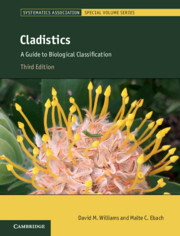Book contents
- Cladistics
- The Systematics Association Special Volume Series
- Cladistics
- Copyright page
- Dedication
- Contents
- Preface
- Acknowledgements
- Introduction: Carving Nature at Its Joints, or Why Birds Are Not Dinosaurs and Men Are Not Apes
- Part I The Interrelationships of Organisms
- Part II Systematics: Exposing Myths
- Part III The Cladistic Programme
- Part IV How to Study Classification
- Part V Beyond Classification
- Afterword
- Index
- Systematics Association Special Volumes
- References
Part V - Beyond Classification
Published online by Cambridge University Press: 20 July 2020
- Cladistics
- The Systematics Association Special Volume Series
- Cladistics
- Copyright page
- Dedication
- Contents
- Preface
- Acknowledgements
- Introduction: Carving Nature at Its Joints, or Why Birds Are Not Dinosaurs and Men Are Not Apes
- Part I The Interrelationships of Organisms
- Part II Systematics: Exposing Myths
- Part III The Cladistic Programme
- Part IV How to Study Classification
- Part V Beyond Classification
- Afterword
- Index
- Systematics Association Special Volumes
- References
- Type
- Chapter
- Information
- CladisticsA Guide to Biological Classification, pp. 351 - 429Publisher: Cambridge University PressPrint publication year: 2020
References
References
References
References
References
Further Reading
General Matters
Codes, Taxonomy and Nomenclature
References
Further Reading
Inspiration for this paper was largely as a response to the contributions of Charles Godfray, and while they are not without some merit, his position reflects that of a ‘user’ rather than practitioner (‘Godfray is a user of taxonomic end-products who has frequently been critical of the slowness with which modern taxonomy is furnishing these—especially species names—to ecologists, conservationists, ‘biodiversity scientists’, etc. … Godfray’s criticism, echoed in other circles … is cast in what he has termed the ‘second bioinformatics crisis’, viz. that the alleged lethargy of modern taxonomy is mostly due to the lack of an adequate cyberstructure to disseminate its much needed products’, p. 141). Having noted that, it is worth dipping into some of Godfray’s papers to understand some of the technical possibilities for data storage (e.g., Godfray, HCJ. 2002. Challenges for taxonomy. Nature 417: 17–19; Godfray, HCJ. 2007. Linnaeus in the information age. Nature 446: 259–260; Godfray, HCJ., Mayo, SJ. & Scoble, MJ. Pragmatism and rigour can coexist in taxonomy. Evolutionary Biology 34: 309–311).
In relation to this paper, see: Flowers, RW. 2007. Taxonomy’s unexamined impediment. The Systematist 28: 3–7; Flowers, RW. 2007. Comments on ‘Helping Solve the “Other” Taxonomic Impediment: ‘Completing the Eight Steps to Total Enlightenment and Taxonomic Nirvana’ by Evenhuis (2007). Zootaxa 1494: 67–68 (‘Many taxonomists in my age cohort are now “molecular systematists”, and I know that some of them became so because they saw that funding would be impossible otherwise. If funding became linked to describing new species, you can bet that many would switch back, some reluctantly but others gladly’, p. 68).
A philosopher’s viewpoint. Perhaps if less time was spent agonising over species, progress would be had.
‘Thinking of naming systems as conventions may help clarify what we should be doing, if we are not to squander both the time and the reputation of systematics. Time is in short supply and our reputation not what it might be; solving the less cosmic issues may involve a self-discipline that also seems in short supply in the systematic community’.
This editorial was followed by a series of comments, all worth reading in the context of the future of taxonomy (Science 305: 1104–1107, includes five contributions).



